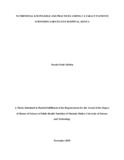NUTRITIONAL KNOWLEDGE AND PRACTICES AMONG CATARACT PATIENTS ATTENDING SABATIA EYE HOSPITAL, KENYA
Abstract
Cataract, the leading cause of blindness and visual impairment globally, induces damage to the eye through mechanisms like oxidative stress. Antioxidants are the first line of defense against oxidative stress and are primarily obtained through diet. High intake of food sources of antioxidants has a protective association with the incidence and progression of cataract while poor intake of foods rich in antioxidants has a negative association with the incidence and the progression of cataract. The general objective of this study was to establish the nutritional knowledge and practices among cataract patients attending Sabatia Eye Hospital, Kenya. An analytical cross-sectional study was conducted on a sample size of 144 patients and the study area and study population were purposively selected. Using a structured questionnaire, data was collected on demographic and socio-economic characteristics, nutritional knowledge and nutritional practices among the patients. Data collected was subjected to analysis using Social Package for Statistical Sciences version 20 and presented using tables and figures. The study findings showed that 59% (n=85) of the respondents were female and the most represented age group was 60 years and above with a frequency of n=116 (80.6%). Almost half of the respondents (n=69, 47.9%) attained only primary education followed by 20.1% (n=29) who attained secondary education. The main source of income for most of the respondents (n=68, 47.2%) was farming and 49.3% (n=71) received less than 5,000 shillings per month. The mean score on knowledge (56.1) was used as the knowledge threshold to put patients into two levels: below average and above average. Less than half, 42.4% (n=61) scored above average on knowledge. In terms of practices, the most frequently consumed antioxidant rich food source was green leafy vegetables consumed by about 66.7% (n=96) at a frequency of once per day. Beans were the highest consumed phytochemical food source by 59.6% (n=82); 3 – 6 times a week and whole grains as a fiber source by 82.6% (n=119) patients once per day. The average individual dietary diversity score was moderate; 6.5 with the most consumed food group being cereals. However, antioxidant rich food groups had the least scores in the diet diversity. The use of nutrient supplements was poorly reported with about 93.8% (n=135) indicating that they never use nutrient supplements. Relationship between the variables of the study indicated that there was a significant positive association between nutritional knowledge and dietary diversity (r(144)=.243, p=0.003) and between dietary diversity score and income level which was (r(144)= .334, p=0.001). The study concluded that the patients’ nutritional knowledge exists but not to all and the frequency of consumption and the diet diversity of antioxidant rich foods is low. Based on the findings, the study recommended for sensitization on frequency of intake of antioxidant food sources to be done at the community and hospital level through a multidisciplinary approach. The study further recommended for a follow up study to be done at the household level to assess other aspects of practice such as food preparation which has an effect on nutrient status of food.

